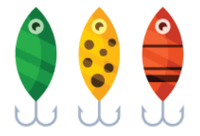The Science Behind Fishing Lure Colors and Patterns
Choosing the right colors and patterns for your fishing lures can significantly impact your success on the water. Understanding how fish perceive colors and patterns, and how different environmental factors influence visibility, can help you make informed decisions when selecting lures. In this article, we will delve into the science behind fishing lure colors and patterns and provide tips for choosing the best options for various fishing conditions.
How Fish Perceive Colors
Fish have different visual capabilities compared to humans, and their ability to perceive colors can vary based on species and water conditions. Generally, fish can see colors, but their perception is influenced by light, water clarity, and depth.
Color Visibility in Water
The visibility of colors in water is affected by the absorption and scattering of light. Here are some key points to consider:
- Red: Red is the first color to be absorbed as depth increases, becoming less visible in deeper water.
- Orange and Yellow: These colors remain visible at moderate depths but can also fade as depth increases.
- Green and Blue: Green and blue colors are the most visible at greater depths, as they are less absorbed by water.
Choosing Lure Colors Based on Water Conditions
Matching your lure colors to the water conditions can improve your chances of attracting fish. Here are some guidelines for selecting lure colors:
Clear Water
In clear water, natural colors such as silver, green, and brown are effective. These colors mimic the natural prey of fish and appear more realistic.
Learn more about how to match the hatch with fishing lures to enhance your lure selection.
Murky or Stained Water
In murky or stained water, bright and contrasting colors such as chartreuse, white, and black are more visible. These colors stand out against the background and attract fish from a distance.
Deep Water
In deep water, use lures with blue and green colors, as these are the most visible at greater depths. Metallic finishes can also help reflect light and attract fish.
The Role of Lure Patterns
In addition to colors, the patterns on fishing lures play a crucial role in attracting fish. Patterns can mimic the scales of baitfish, the stripes of prey, or other natural markings. Here are some common patterns and their benefits:
Striped Patterns
Striped patterns can mimic the natural markings of baitfish and other prey. They create a lifelike appearance that can trigger strikes from predatory fish.
Spot Patterns
Spot patterns can resemble the appearance of fish eggs or other prey. These patterns can be particularly effective for attracting fish during spawning seasons.
Flash and Holographic Patterns
Flash and holographic patterns can reflect light and create a shimmering effect in the water. These patterns can attract fish from a distance and are effective in both clear and murky water.
Experimenting with Colors and Patterns
Experimenting with different colors and patterns can help you determine what works best in specific fishing conditions. Here are some tips for experimenting:
Keep a Variety of Lures
Having a variety of lures in different colors and patterns in your tackle box allows you to adapt to changing conditions and target different species.
Observe Fish Behavior
Pay attention to how fish respond to different colors and patterns. If you're not getting bites, try switching to a different color or pattern to see if it makes a difference.
Adjust Based on Conditions
Consider the time of day, weather, and water conditions when selecting lure colors and patterns. Fish behavior can change with these factors, so it's essential to adapt accordingly.
Understanding the science behind fishing lure colors and patterns can help you make more informed decisions when selecting lures. By considering how fish perceive colors, matching your lures to water conditions, and experimenting with different patterns, you can increase your chances of a successful catch. Remember to adapt to changing conditions and observe fish behavior to refine your lure selection. Happy fishing!


